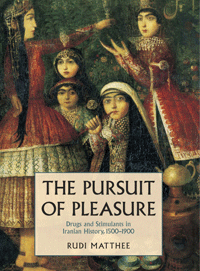
Bowlful of fruity meaning
Part I: Etymology of Anar
December 1, 2005
iranian.com
This is the time of the year when the fruit bowl that sits atop the eating counter in my kitchen begins to reflect the autumnal colors outdoors. In this still life the color orange is represented by the seedless narengi (tangerine), the mellowing bananas provide the browning yellow. But dominating it all in color and presence is the anar (pomegranate). I love pomegranate. Unlike any other fruit, perhaps with the exception of coconut or pineapple, it requires labor and precision in bringing its marvelous rewards to the lips. And, boy, is it ever worth it!
In my recipe, I first seed the pomegranate in a bowl that is nestled deep in the sink in order to avoid an excessive marking of the surroundings with the microscopic squirts of the juice. An average size pomegranate yields a few hundred fleshy vesicles (douneh). I then slice up a narengi or two and add it to the seeds. A dash of salt and pinch of golpar later – I am ready for a mouthwatering experience. What I like most about this concoction is that it assembles in most complimentary way all the four basic tastes -- the sweet and sour of the tangerine and pomegranate, salinity of salt, and bitterness of golpar. The dictionary defines golpar as Persian marjoram, origan, mountain-pride, angelica. But like gojeh (green baby plum) golpar defies definition, it is experienced.
In Farsi, the word for pomegranate is anar, for which the poetic nar is a contraction. The pomegranate blossom is appropriately called golnar (also gol-e anar,nargol), literally, flower (gol) of pomegranate.
According to Encyclopaedia Britannica, the Punica granatum is the size of a large orange and its skin color ranges from brownish yellow to red; it is considered indigenous to Iran and early on its cultivation encircled the Mediterranean and extended through Arabian Peninsula, Afghanistan and India. Regardless, due to its caloric content, if memory serves, anar is classified in the Iranian culinary folklore as a garmi (warm) fruit.
According to the Oxford English Dictionary, the word pomegranate in English consists of derivations from the Latin ponum (fruit) and granatum (grainy, seedy). In Old French, the fruit was called pomme granatum in which pomme had come to mean apple and granatum (Italian: granata; Spanish: granada) referred perhaps less to the seedy nature of the fruit but rather its place of origination in Granada. In modern French the fruit is called simply grenade.
According to Encyclopaedia Britannica, the city of Granada in southern Spain owes its name either to the Spanish granada (pomegranate), a locally abundant fruit that appears on the city’s coat or arms, or to the Moorish name from the place that was Karnattah (Gharnatah) possibly meaning “hill of strangers.” My money is on the first explanation, which could interpret the Moorish name of the place as a corruption of the place’s Spanish name having something to do with the pomegranate.
 Because pomegranate is indigenous to Iran one naturally tends to assume that the Farsi word anar should be Persian. In Arabic the word anNar means fire and, according to the Dictionary of Islam, it occurs in the Koran very frequently for hell. According to my Haim Farsi-Inglisi Dictionary, in Farsi too the word nar means fire and its plural niran means hell. From my childhood, however, I recall the saying that anar mieveh beheshtist (pomegranate is a paradisiacal fruit). Because pomegranate is indigenous to Iran one naturally tends to assume that the Farsi word anar should be Persian. In Arabic the word anNar means fire and, according to the Dictionary of Islam, it occurs in the Koran very frequently for hell. According to my Haim Farsi-Inglisi Dictionary, in Farsi too the word nar means fire and its plural niran means hell. From my childhood, however, I recall the saying that anar mieveh beheshtist (pomegranate is a paradisiacal fruit).
Exactly how the presumptively infernal fruit became suddenly heavenly was not clear to me until now. According to the hadith (Islamic parables), per Encyclopaedia Britannica, the Prophet Mohammad remarked, “Eat the pomegranate, for it purges the system of envy and hatred.” My guess is that the Prophet’s urging was necessary in order to educate the hoards that had considered the fruit hellish, evil! The fact of the hadith, if it is to be believed, makes a strong case for the Farsi word anar to be of Arabic origin. Not!
The key to understanding nar or anar as a Persian word is in the adjective anaryn, which, according to Haim, is synonymous with zang, a general word in Persian for oxidization of many different substances.
The color of iron rust is the same as the brownish-reddish color of the pomegranate skin. I posit that in Persian the word for brownish-reddish rust would have been anar, from which derived anaryn (rusty). It would have been made up of anar, plus yn, like in rang (color) and rangyn (colorful). The relation between the Arabic anNar (fire) and Persian anar (pomegranate) could therefore be coincidental. I tend to think that Arabic, in which the common word for fire is harq, probably derived the word anNar from the Persian anar, which reminded the Arabic speaker of the color of fire. That Arabic would be receptive to taking in the Persian anar is evident in Arabic word narjyl from the Persian nargyl, meaning coconut. Another example of Arabicization of a Persian fruit name is narenj, which in Persian is narang.
More about narangi and porteghal, next week.
About
Guive Mirfendereski is a professorial lecturer in international relations and law and is the principal artisan at trapworks.com. Born in Tehran in 1952, he is a graduate of Georgetown University's College of Arts and Sciences (BA), Tufts University's Fletcher School (PhD, MALD, MA) and Boston College Law School (JD). He is the author of A Diplomatic History of the Caspian Sea >>> Features in iranian.com
|